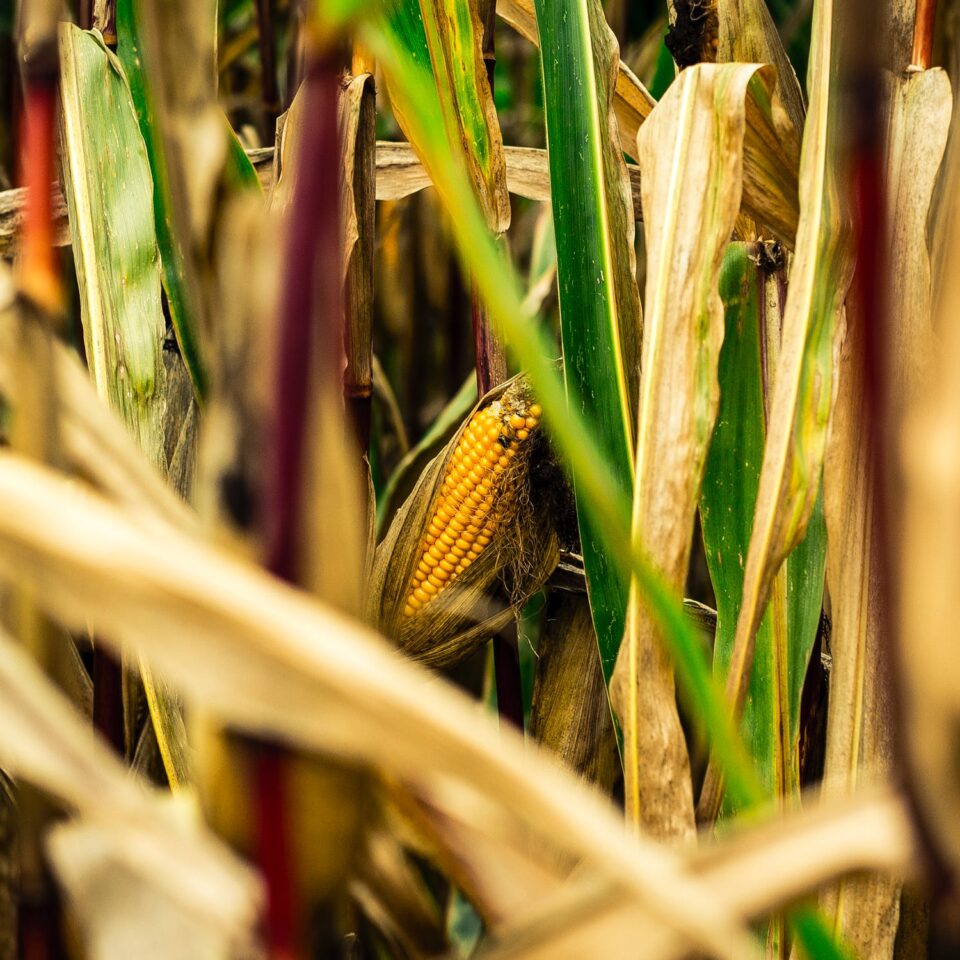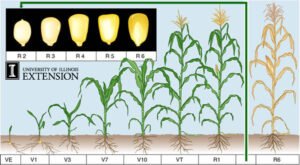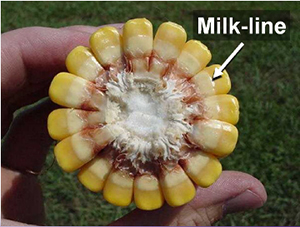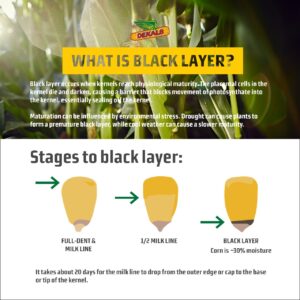
Can I Count on an Early Harvest?
It’s that time of year again when growers look at their corn crop and wonder how long it will be until harvest. It’s also time to calculate if they will be able to harvest a bit early to get a market premium for early corn. Harvest time is very dependent on corn planting date, hybrid maturity, and heat unit accumulation through the summer. Estimating harvest dates can give you a heads up to when you need to get machinery ready, how to adjust your marketing plan, as well as a good excuse for checking the crop’s condition in the field.
Corn Staging

Image Source: Odell’s World
Knowing what stage your crop is at can give you a good idea of what your harvest timeline could look like.
The kernel begins its growth from fertilized silks at Stage R1 – Silking. After that, the kernel develops and adds weight through several stages:
R2 – Blister: 10-14 days after Silking stage
- Kernels filled with clear fluid
- Begin accumulation of dry matter
R3 – Milk: 8-10 days after Blister stage
- Yellow kernel with milky fluid
- Rapid grain filling period
R4 – Dough: 6-8 days after Milk stage
- Inner fluid becomes thick and pasty
- Top of kernel begins to firm up
R5 – Dent: 11-14 days after Dough stage
- Distinct line near the top of the kernel called the “Milk Line” noticeable
- Milk Line advances toward the tip as the crop matures o Whole plant moisture suitable for silage harvest
- 90% of grain yield reached by ½ Milk Line
R6 – Maturity: 20-25 days after Dent stage
- Physiological maturity, corn plant has completed its life cycle
- Kernels have achieved maximum dry weight
- However must still dry down for proper harvesting
- Also known as “Black Layer” stage
How Far Away is My Corn from Harvest?
Once corn reaches the R5 (Dent) stage, it becomes easier to see the progression in the cobs in the field. The Milk Line present can give a good indication of how the kernels are progressing putting on weight.
In Ontario, it can take around 20-25 days to reach R6 stage from R5, and from there just needs to dry down to harvest moisture. Generally if the weather is good it will take approximately 10 days from 50% milk line to reach black layer. By splitting your cob in half and looking at the kernel you can start to make estimations as to where the milk line is and how long (if the weather cooperates) that it will be until black layer.

Image Source: Hay & Forage Grower
What is the Black Layer?
Black layer is when the cells at the bottom of the kernel discolour and eventually collapse; this blocks photosynthate movement into the kernel creating what looks like a dead black tip at the bottom of a kernel. At this stage kernels are then considered mature and safe from frost. The moisture in the kernel is typically around 30% to 35% (can range from 25% to 40%). Any stresses (like frost) following this stage generally do not have a big impact on yield. The kernels have achieved maximum dry weight but moisture loss will still be needed for suitable threshing. OMAFRA states that on a normal year, R6 should occur sometime in mid-late September, depending on hybrid maturity, heat unit accumulation, etc.

Image Source: Dekalb Asgrow
Stresses that Affect Final Maturity Date
There are many factors that affect the final maturity date of a variety. Cool temperatures, especially nighttime temperatures, slows the transfer of photosynthates to the kernel, delaying maturity. Insect and disease stress that cause damage to the plant will lower the overall energy reserves. In this case, maturity can occur earlier as there is less energy for the plant to move into the grain. Keeping the plant healthy through the use of fungicides, nutritional products, insecticides, etc. will maintain the plant’s energy reserves that can be transferred into the grain allowing the plant to reach its full maturity potential.
Predicting Black Layer Date
The maturity date of a corn hybrid is determined by the accumulated crop heat units (CHU). CHUs are based on the daily maximum and minimum temperature throughout the growing season. You can calculate the rough maturity date based on the current accumulated CHUs from your planting date until now. The CHU maturity rating when you purchase corn hybrids is the total amount of CHUs that your crop will need to achieve black layer and physiological maturity.
Dry Down Following Maturity
It is possible for corn to lose 1% moisture per day when weather is favorable. Generally 0.4% – 0.6% per day is more realistic in Ontario. The temperature and hybrid traits will determine the speed of dry down. Warmer temperature contribute to faster drying. Hybrid traits such as: husk leaf number, husk thickness, husk tightness, coverage of the ear, and how the cob folds over when it is mature will all influence the dry down time. Corn can be harvested wet and dried to proper storage temperatures but this can be expensive. Never harvest above 28% moisture as damage to the kernel can occur.
Conclusion
As harvest approaches, it’s important to be aware of your crop’s maturity before contracting early harvest premiums for the crop. And also essential to calculate what the difference in cost will be to you as a producer to harvest early vs harvest later when the crop is drier, as well as limit losses in the field by harvesting at the correct maturity.
Additional Sources: Farms.com, Purdue Ag, Hyland Corn and Soybean Field Guide, OMAFRA, CCA Ontario, Thomas Country Ag, Michigan State University, Hubner Seed